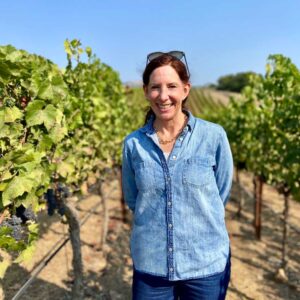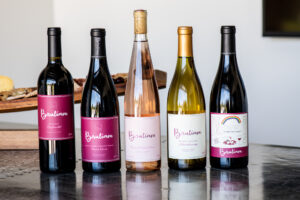The Art & Science of Wine with Kerith Overstreet ’98M (MD)
The Art & Science of Wine with Kerith Overstreet ’98M (MD)
This physician-turned-winemaker runs Bruliam, a boutique winery in Sonoma County.
 Kerith Overstreet always knew that someday she’d go to medical school. She grew up loving science, writing, problem-solving, and paying attention to details—all skills that physicians need. After graduating from Cornell University with a degree in English, she pursued her dream and attended the University of Rochester’s School of Medicine and Dentistry (SMD).
Kerith Overstreet always knew that someday she’d go to medical school. She grew up loving science, writing, problem-solving, and paying attention to details—all skills that physicians need. After graduating from Cornell University with a degree in English, she pursued her dream and attended the University of Rochester’s School of Medicine and Dentistry (SMD).
It was the perfect place for her. The school welcomed students who came from a wide variety of academic disciplines and had a sharp mind for medicine. While at SMD, Overstreet discovered something new: a passion for wine.
“My medical school friends and I would go in on cases of our favorites—and we enjoyed the 15 percent discount that came with buying in bulk,” says Overstreet, with a smile. “Together, we discovered the fun and fruitiness of Beaujolais, the elegance of pinot noir, and the crispness in a cold glass of chardonnay. It was such a great time of life—gathering with friends, talking about rotations, and making memories over a glass of wine.”
Coming home
After graduating from medical school in 1998, Overstreet returned home to California to complete a residency in surgical pathology, followed by two fellowships. In 2007, she had an opportunity to crush fruit at a cooperative urban winery in San Francisco. That experience confirmed what her gut was saying: to pursue a career in wine. Overstreet then enrolled in UC Davis, where she took what she learned in medical school and applied it to enology: the study of wines.
Then, in 2008, Overstreet opened Bruliam Wines, which has since become a boutique producer of single vineyard pinot noir, zinfandel, rosé, and chardonnay. Having started with a single barrel, Bruliam now produces about 1,200 cases per year.
Overstreet sources her grapes from vineyards in Sonoma County—including her own estate pinot noir vineyard, Torrey Hill—and from the Santa Lucia Highlands.
“Like all physicians, I invested a lot of time and heart in my medical training,” she says. “Leaving wasn’t easy, but after 15 years of winemaking, it’s clear that I draw on the same skill set every day, just differently. To me, winemaking is a magical elixir of science and art, just like the best physicians combine rigor and technique with a big dose of humanity.”
Making a great bottle of wine

Winemaking, Overstreet says, is not such a far cry from medicine. “I used to look at cross sections of tissue. Now I look at cross sections of grapes,” she says. Overstreet adds that in medical school, she was taught the biopsychosocial approach to patient care and learned how important it was to assess the whole patient to improve health outcomes.
“It’s similar in winemaking,” she says. “We have to integrate a variety of factors that affect the production of a great wine, including sweetness, acidity, tannin, alcohol, and body. There’s art involved in the process, too—intuition, writing skills, design savvy, and the ability to connect with people are vital. Every year offers a new vintage and a new challenge.”
As a winemaker, Overstreet still makes rounds. She wakes early, walks the vineyards, plans a grape-picking schedule, and does whatever the season requires. For instance, when producing red wines, her first job each morning is to check temperature and sugar levels in each tank. “If a tank overheats, the yeast in it can die and fermentation will stop,” she says. “That can’t happen—I have to make sure my grapes don’t get chilled or come down with something like a fever.”
The business of wine
Bruliam is housed within a shared production facility, which makes it possible for small, boutique brands like Overstreet’s to run a business without the capital investment in large equipment like crushers/destemmers and presses. The facility provides her access to state-of-the-art production equipment along with the physical space needed to focus on hospitality, offer private tastings, and provide guests with distinctive experiences.
Overstreet is also intimately involved in all aspects of the business—from farmer to winemaker to marketer to everything in between. “On any given day, I could be sampling grapes, writing tech sheets, jotting down tasting notes, packing boxes, or testing the sugar content in the grapes,” she adds. “I love the variety and wouldn’t have it any other way.”
Bringing people together
Overstreet especially enjoys the people part of the business. “Customers always remind me that I’m right where I need to be,” she says. “I love getting photos from them that showcase a bottle of Bruliam alongside a hike to a waterfall, at a grandchild’s wedding, or as a way to celebrate a new job, retirement, or neighborhood get-together.” She adds that now, during this nearly post-pandemic reality, people are excited about gathering in groups again, to share food and wine, and to lubricate their social machinery.
“Share a bottle of wine from California or New York or Italy or wherever and people inevitably talk about how that particular wine reminds them of a past vacation, a great meal, or some special moment in their lives,” she says. “Wine brings people together—it’s such a privilege to be a part of that.”
Discover fall recipes along with wine pairing suggestions by Overstreet.
What’s in a name?
Overstreet and her husband of 24 years, Brian, have three children: Bruno, a first-year college student, and 16-year-old twins, Lily and Amelia. The name “Bruliam” combines the first two letters of their kids’ names. The Bruliam logo also features three meaningful dots: two close together to represent the twins and a third for Bruno. The name also plays on Overstreet’s passion for science. “The word ‘Bruliam’ just sounds like it could be found in the periodic table of elements,” says Overstreet. “It’s even part of our tagline, that here at Bruliam, wine is ‘elemental.’”
This story originally appeared in the fall 2022 issue of the Buzz.
— Kristine Kappel Thompson, November 2022



 Looking to make connections with fellow alumni?
Looking to make connections with fellow alumni?